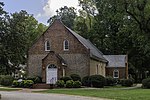Pembroke Manor
1764 establishments in VirginiaGeorgian architecture in VirginiaHampton Roads, Virginia Registered Historic Place stubsHouses completed in 1764Houses in Virginia Beach, Virginia ... and 2 more
Houses on the National Register of Historic Places in VirginiaNational Register of Historic Places in Virginia Beach, Virginia

Pembroke Manor is a historic home located at Virginia Beach, Virginia. It was built in 1764, and is a two-story, five-bay, Georgian style brick dwelling. It is topped by a shallow hipped roof.It was added to the National Register of Historic Places in 1970.
Excerpt from the Wikipedia article Pembroke Manor (License: CC BY-SA 3.0, Authors, Images).Pembroke Manor
Hinsdale Street, Virginia Beach
Geographical coordinates (GPS) Address Nearby Places Show on map
Geographical coordinates (GPS)
| Latitude | Longitude |
|---|---|
| N 36.852222222222 ° | E -76.133888888889 ° |
Address
Ivy League Academy
Hinsdale Street
23462 Virginia Beach
Virginia, United States
Open on Google Maps







